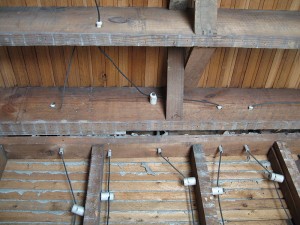
by admin | Dec 18, 2012 | Electrical, Saftey
 The majority of homes in Downtown Windsor were built prior to 1940. As a result most still have knob and tube wiring. Knob and Tube was an original form of wiring and was used from 1880 to the 1930s.
The majority of homes in Downtown Windsor were built prior to 1940. As a result most still have knob and tube wiring. Knob and Tube was an original form of wiring and was used from 1880 to the 1930s.
As existing Knob and Tube (K& T) wiring gets older, insurance companies may deny coverage due to a perception of increased risk. Several companies will not write new homeowners policies at all unless all K&T wiring is replaced, or an electrician certifies that the wiring is in good condition. Also, many institutional lenders are unwilling to finance a home with limited ampacity (current carrying capacity) service (which, as noted above, often goes hand-in-hand with K&T wiring), unless the electrical service is upgraded.
It is usually easily seen in unfinished basements by the Cermamic knobs and tubes used. Knob and tube wiring was eventually displaced from interior wiring systems because of the high cost of installation compared with use of power cables, which combined both power conductors of a circuit in one run (and which later included grounding conductors).
Many home owners have removed visible knob and tube from their basements, as some insurance companies felt the old exposed wiring was unsafe. However removal of knob and tube from within walls and ceilings throughout a house is often not completed do to its expense. As well some insureace companies only require removal of exposed wiring.
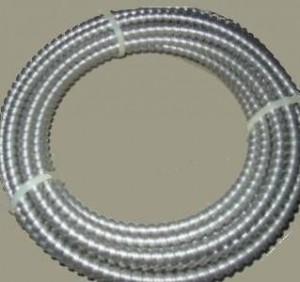
I have seen some home owners run steel armoured BX conduit outside of walls to replace knob and tube. While this may provide a ground, it is unattractive.
Another way of recognising the potential presence of knob and tube wiring in a home is two prog plug receptacles. As knob and tube never had grounds, older plug receptacles had only 2 sockets without a ground.
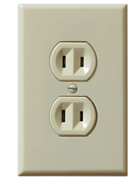 2 prong plug (receptacle)
2 prong plug (receptacle)
Two prong outlets are rather inconvenient as grounded plugs to not fit into them. In additon two prong plugs can create a safety hazard. The third prong on a plug is designed to give a fault path in the event the hot wire, or device that is connected to should short out.
The absence of a ground path can lead to a electrical shock. For example a metal light fixture could become energized on its exterior, and the lack of grounding will not allow the breaker to trip.
The problem is that you cant necessarily just replace them with a three prong plug. If the wiring system is not bonded to ground, then that would be an illegal fix. A three prong plug tester will show “open ground”. In fact it is a good thing you can do yourself.
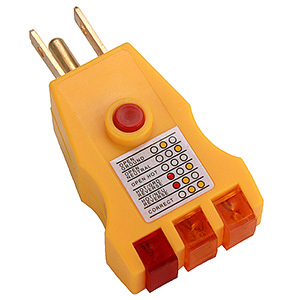
Go around and check every plug in your house with a tester. They are readily available, and only a few dollars.
In some cases the wiring is grounded and they just didn’t put three prong plugs, because they were cheaper. In many cases there is no wire, or other grounding path.
It is likely that your old two prong plug is so loose that cords fall right out of it, or it is brittle and cracking. Either way it should be replaced. At this point you have two choices that are legal. Replace it with a new two prong receptacle is one. The other is replace it with a three prong plug, but only after verifying that you have a ground path.
What if you do not have a ground, but you want a 3 prong plug anyway?
GFI receptacle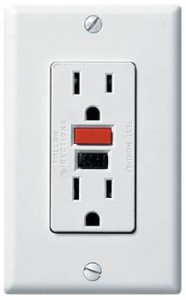
The answer GFI is to protect the circuit. This can be done with a breaker, or a receptacle. It is possible for a single GFI outlet to protect the entire circuit that feeds off of it.
The reason that this is legal is because the GFI receptacle can detect minute levels of leakage current, and open the circuit. In fact it does it a lot faster than the breaker would. This is why they are required near sources of water, or outside.
There used to be a time where someone would grab a drill while standing in a puddle and get killed. With a GFI, they wouldn’t even feel a tingle. It would instantly shut off power.
Using an electrician is always recommended to ensure everything is completed to building code.
This is a very big deal if you want to sell your house.

by admin | Feb 29, 2012 | Blog, Electrical
Smart Meters are Here
As part of a provincial initiative to encourage energy conservation and help Ontario consumers manage their electricity costs, ENWIN is now installing Smart Meters throughout Windsor. The Ontario Energy Board (OEB) has directed energy providers, like ENWIN, to install Smart Meters in all Ontario homes and small businesses, encouraging the development of a province-wide “culture of conservation”. As Windsor’s energy provider, ENWIN is mandated to complete local Smart Meter installations by early 2011.
Everything Stays the Same
It is important for customers to realize that everything will remain the same, following your Smart Meter Installation: An ENWIN employee will still come to read the meter, EnWin bills will still look the same, and electricity charges will still be calculated in the same way as before. Eventually, the province is expected to switch over to a new rate structure called Time-of-Use (TOU) pricing. But for now, only the appearance of the meter will change.
TOU Pricing is NOT in Effect
Smart Meters are here, but Time of Use Pricing isn’t. Not yet. You will not automatically move to time-of-use rates once your smart meter has been installed. Provincial legislation requires ENWIN to install Smart Meters as one step towards conserving energy and building for the future. Smart Meters will be installed this fall – but that will NOT have an immediate impact on how you are billed for your electricity. ENWIN customers will be billed differently ONLY after the Province requires us to move to Time of Use billing – likely some time in 2012. When a firm date is set, ENWIN will contact customers directly, and make sure you have all the information you need to benefit from the change. At the present time you will not notice any difference in your billing.
ENWIN Respects and Protects Your Privacy
As we move forward with Smart Meter installations, remember that Time of Use pricing is not yet in effect. In the future, when the Province requires ENWIN to move to this new system, Smart Meters will help customers reduce their energy costs by offering clear information about much energy is used at specific times of day. How and why you consume energy will remain, as always, private. ENWIN will ensure you are aware of all changes before they occur, and we thank you for helping Ontario build a brighter future.
Quick, Efficient Installation
Installation only takes a few minutes. A representative from ENWIN’s contractor, Olameter, will knock on your door to inform you that they are there to install your smart meter. Your power will be interrupted briefly, while the old meter is exchanged for a new Smart Meter. If you are not home, the representative will complete the installation and leave a door hanger to inform you that your Smart Meter has been installed. Customers may find they need to reset digital clocks and other electronic devices, following the installation.
Look for the Olameter Logo
ENWIN has contracted with Olameter Utility Solutions to install smart meters in the Windsor area. Customers are asked to look for the Olameter logos on installers’ vehicles and ID tags. Olameter representatives will not ask to see your utility bill, and you will not be required to sign anything.
Reliable and Secure
Smart meter installations are now underway, as part of the Ontario government’s mandate to create a “culture of conservation”, and build a reliable, secure and healthy energy future. When the Province requires ENWIN to move to Time of Use pricing – likely some time in 2012 – EnWin’s Smart Meters will record frequent, accurate meter readings. This will allow customers to take advantage of lower energy prices, whenever possible throughout the day. ENWIN is using the knowledge gained by front runners in the Smart Meter installation process, to ensure your Smart Meter is reliable and secure.
The Smart Energy Future
When TOU pricing comes into effect in Windsor, energy providers will be required to vary prices for electricity according to demand levels at the time of use, with higher prices being charged during peak demand periods and lower prices during mid-peak and off-peak periods. This pricing structure is intended to encourage consumers to think more about how and when they use electricity, and move their consumption away from more expensive times of the day.
Smart Meter, Smart Consumer
Electricity bills will be much more precise, based on the hourly readings taken and sent by the Smart Meter. And “smart” energy users will be part of a new program provincial program that will reduce peak demand, and lessen stress on Ontario’s electricity system.
Time-of-use (TOU) Prices
Time-of-use pricing is changing effective May 1, 2011. (Prices subject to change every 6 months)
Based on typical residential consumption patterns, the estimated TOU bill impact is an increase of about 3.8% on the total bill, or $3.96 per month, for residential consumers who use 800 kWh of electricity a month.
It is expected there will be approximately 3 million customers on TOU billing by June 2011, with more being switched to TOU billing over the summer and through the fall.

10 Smart Meter Lane
Take a tour of 10 Smart Meter Lane to see how you can better manage your electricity costs when Time-of-Use (TOU) pricing comes into effect. This interactive tool shows how running appliances at different times of the day or week can impact your electricity bill.

 The majority of homes in Downtown Windsor were built prior to 1940. As a result most still have knob and tube wiring. Knob and Tube was an original form of wiring and was used from 1880 to the 1930s.
The majority of homes in Downtown Windsor were built prior to 1940. As a result most still have knob and tube wiring. Knob and Tube was an original form of wiring and was used from 1880 to the 1930s.






